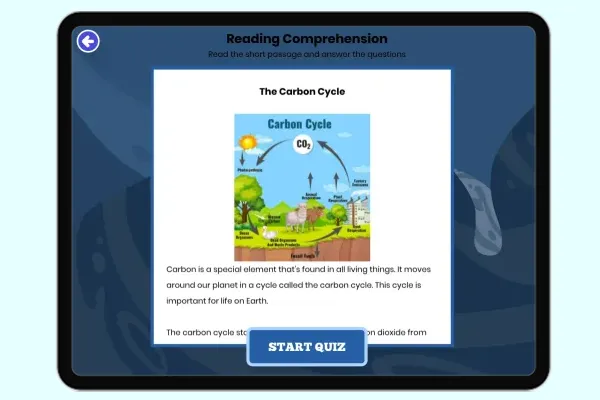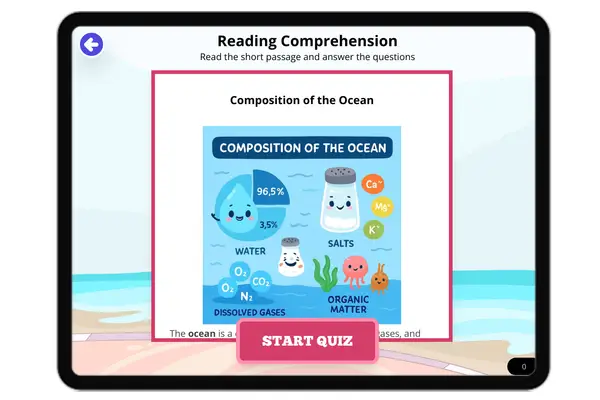Earth's Systems Curriculum Resources
Explore Earth's Systems concepts with our comprehensive science curriculum resources aligned with NGSS standards. Interactive and printable resources for K-12 learners across all grade levels.
The Water Cycle
The water cycle describes how water continuously moves through our planet via evaporation, condensation, precipitation, ...
RI.4.4RI.4.2
The Carbon Cycle
The carbon cycle shows how carbon travels through the atmosphere, living organisms, and the Earth. It maintains the bala...
RI.4.4RI.4.2
The Nitrogen Cycle
The nitrogen cycle describes how nitrogen moves through the air, soil, and living organisms. It involves processes like ...
RI.4.4RI.4.2
The Phosphorus Cycle
The phosphorus cycle explains how phosphorus moves through rocks, soil, water, and living things. Essential for DNA and ...
RI.4.4RI.4.2
The Oxygen Cycle
The oxygen cycle illustrates how oxygen moves through the atmosphere, water, and living organisms. Driven by photosynthe...
RI.4.4RI.4.2
Understanding the Carbon Cycle
The carbon cycle explains how carbon moves through the environment, plants, and animals. Processes like photosynthesis a...
RI.4.4RI.4.2
Understanding the Phosphorus Cycle
The phosphorus cycle details how phosphorus travels through rocks, soil, water, and organisms. Essential for DNA and bon...
RI.4.4RI.4.2
Understanding the Oxygen Cycle
The oxygen cycle explains how oxygen circulates through air, water, and living organisms. Plants produce oxygen during p...
RI.4.4RI.4.2
The Great Barrier Reef
This passage introduces the Great Barrier Reef, a magnificent underwater ecosystem off the coast of Australia. It descri...
RI.3.1RI.4.1
Measuring Carbon Stored in Vegetation
Measuring carbon stored in vegetation is crucial for understanding climate change. Plants absorb CO₂ during photosynthes...
7.RI.7.1
The Water Cycle: Earth's Recycling System
This educational reading passage explores the water cycle - Earth's natural system for recycling water that has existed ...
The Gaia Hypothesis
The Gaia Hypothesis, proposed by James Lovelock, suggests that Earth functions like a living organism, with all its part...
Determining Earth's Carrying Capacity
Earth's carrying capacity refers to the maximum number of people the planet can support sustainably. This depends on fac...
Conserving Forests for Water Supply
Forests play a critical role in maintaining clean water supplies and regulating the water cycle. Conserving upstream for...
7.RI.7.3
Four Ways Forests Affect the Atmosphere
Forests play a vital role in regulating the atmosphere by absorbing CO₂, producing oxygen, cooling temperatures, and imp...
7.RI.7.1
Landform Types Word Sort
This classification activity helps students understand how different landforms are created. Students sort various Earth ...
4-ESS2-2
Weathering Types Word Sort
This classification activity helps students understand different types of weathering processes. Students sort various ex...
4-ESS2-1
Tracking Earth's Water
The 'Tracking Earth's Water' activity guides students to sort 12 water-related words into freshwater and saltwater categ...
Water Around the World
In 'Water Around the World,' students classify 12 water sources into solid and liquid forms, learning about where water ...
Building a Terrain Model
The 'Building a Terrain Model' activity challenges students to classify 12 landscape features and design a model to repr...
Mapping the Landscape
In 'Mapping the Landscape,' students categorize 12 words into landforms and bodies of water to deepen their understandin...
Topography of the Ocean Floor
This science passage with questions and answers on the ocean floor features diverse landscapes like continental shelves,...
RI.5.3
Composition of the Ocean
The ocean is made up of water, dissolved salts, gases, and organic matter. Its composition varies with depth and influen...
RI.5.3
Circulation in the Ocean
Ocean circulation involves the movement of seawater driven by wind, temperature, and salinity. It includes surface curre...
RI.5.3
Convection Currents in the Ocean
Convection currents in the ocean are driven by temperature and density differences. They play a key role in the thermoha...
RI.5.5
Surface Ocean Currents
Surface ocean currents are driven by wind and influenced by Earth’s rotation. They transport warm and cold water, regula...
RI.5.3
Freshwater and Its Sources
Freshwater is a limited resource, with most stored in glaciers and aquifers. Rivers, lakes, and groundwater are key sour...
RI.5.3RI.6.3RI.7.3
Porosity and Permeability of Soil and Rock
Porosity and permeability are key properties of soil and rock that affect water movement underground. They influence gro...
RI.5.5RI.6.9
Runoff from Precipitation
Runoff from precipitation replenishes rivers and lakes but can cause flooding and pollution. Solutions like rain gardens...
RI.5.3RI.6.3RI.7.3
Large Streams of Moving Water
Large streams of moving water, like rivers and creeks, shape landscapes, support ecosystems, and provide freshwater for ...
RI.5.3RI.6.3RI.7.3
Stream Flow
Stream flow refers to the movement of water in rivers and creeks. It is influenced by precipitation, slope, and human ac...
RI.5.5RI.6.9
What is Transpiration
Transpiration is the process by which plants release water vapor into the atmosphere. It cools plants, contributes to hu...
RI.5.3RI.6.3RI.7.3
The Mississippi River
The Mississippi River is one of the longest rivers in North America, stretching 2,340 miles from Lake Itasca to the Gulf...
RI.5.3RI.6.3RI.7.3
The Colorado River
The Colorado River stretches 1,450 miles from the Rocky Mountains to the Gulf of California. It carved the Grand Canyon ...
RI.5.5RI.6.9
The Amazon River
The Amazon River is the largest river in the world by discharge volume, stretching 4,000 miles from the Andes Mountains ...
RI.5.3RI.6.3RI.7.3
The Mekong River
The Mekong River flows 2,700 miles through six countries in Southeast Asia, ending in the fertile Mekong Delta. It suppo...
RI.5.3RI.6.3RI.7.3
The Brahmaputra River
The Brahmaputra River originates in the Himalayas and flows 1,800 miles through China, India, and Bangladesh, joining th...
RI.5.3RI.6.3RI.7.3
What is a Mineral?
A mineral is a naturally occurring, inorganic solid with a specific chemical composition and crystal structure. Minerals...
RI.5.3RI.6.3RI.7.3
Difference Between a Rock and a Mineral
Rocks are mixtures of minerals, while minerals are naturally occurring, inorganic solids with a specific composition and...
RI.5.3RI.6.3RI.7.3
Do All Minerals Have Crystal Structures?
All minerals have a crystalline structure, but not all form visible crystals. The size and shape of crystals depend on f...
RI.5.3RI.6.3RI.7.3
Rare Earth Minerals in Smartphones and Computers
Rare earth minerals are critical for smartphones, computers, and renewable energy. Mining them has environmental impacts...
RI.5.3RI.6.3RI.7.3
Transform Plate Boundaries: Earth's Sliding Plates
This NGSS aligned nformational passage examines transform plate boundaries where tectonic plates slide horizontally past...
MS-ESS2-3RI.6.1RI.7.4RI.8.2
Types of Plate Boundaries
This science passage explores how geologists use rock formations, fossil distributions, and seafloor structures to ident...
MS-ESS2-3RI.6.1RI.7.4RI.8.2
Divergent Plate Boundary: Where Earth's Crust Pulls Apart
This science passage explains how divergent plate boundaries form where Earth's crust pulls apart, creating features lik...
MS-ESS2-3RI.6.1RI.7.4RI.8.2
Convergent Boundary: When Earth's Plates Collide
This science passage describes three types of convergent plate boundaries (oceanic-continental, oceanic-oceanic, contine...
MS-ESS2-3RI.6.1RI.7.4RI.8.2
How Are Metamorphic Rocks Formed?
This science passage explains how metamorphic rocks form through metamorphism, detailing the effects of heat (150°C-1,00...
MS-ESS2-3RI.6.1RI.7.4RI.8.2
What Type of Plate Boundary Is the San Andreas Fault?
This explanatory passage examines the San Andreas Fault as a transform plate boundary where the Pacific and North Americ...
MS-ESS2-3RI.6.1RI.7.4RI.8.2
Intrusive Igneous Rocks: Formation and Features
This passage explains the formation of intrusive igneous rocks through slow cooling of magma beneath Earth's surface. It...
MS-ESS2-3RI.6.1RI.7.4RI.8.2
Frost Wedging: How Ice Splits Rock
This passage explains frost wedging as a mechanical weathering process. Aligned with NGSS MS-ESS2-1 (Earth’s systems) a...
MS-ESS2-1MS-ESS2-2RST.6-8.3



















































